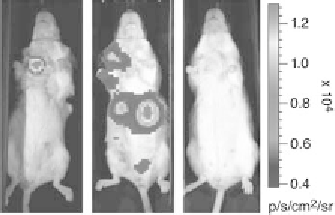Biology Reference
In-Depth Information
implanted device through local or hematogenous seeding
(21)
. Little is known
about the pathogenesis and treatment of this condition, mainly due to lack of
in situ methods to monitor such infections
in vivo
in real time. Thus, we have
applied the
in vivo
imaging technology to monitor and visualize the estab-
lishment and spread of staphylococcal infection non-invasively in mice with
indwelling jugular vein catheter (
see
Fig. 5
and Color Plate 9, following p. 46).
3.10. Experimental Model of Infection
To avoid high operative mortality rate associated with small animal vascular
catheterization, it is advisable to purchase animals that are surgically prepared
and ready to use from a commercial vendor such as Charles River Laboratories.
1. After 5-7 days post-catheterization, infect the catheterized mice intravenously
with 50 μL of bioluminescent bacterial suspension (e.g.,
S. aureus
Xen 29) in
exponential growth phase in PBS through the tail vein with inocula of 10
4
CFUs.
2. Inoculate a group of non-catheterized mice with a similar dose as control group.
3. Image animals using a low-light imaging system (see imaging procedure below).
4. To optimize capture of bioluminescence, shave over the heart (ventral), as well
as kidneys and spleen areas (dorsal).
Fig. 5. Daily imaging of mice inoculated by tail vein injection with
S, aureus
Xen
29 reveals the colonization of
S. aureus
around the indwelling catheter in jugular vein
catheterized mice as early as one day after infection (left). Six days later, evidence of
metastatic disease with staphylococci spreading to heart, kidney, and liver as a result
of seeding of bacteria from the infected vascular catheter (center). In contrast, whole-
body imaging of non-catheterized mice challenged with a similar dose of bacterial
suspension showed no sign of infection around heart or any other organ, even after
a week into the hematogenously induced infection (right). This shows the implanted
device that constitutes a particularly attractive surface for bacterial colonization. The
difference in the degree of infection seen between catheterized and non-catheterized
mice clearly indicates the importance of the indwelling vascular catheter in potentiating
the establishment of infection. (
See
Color Plate 9, following p. 46.)




Search WWH ::

Custom Search